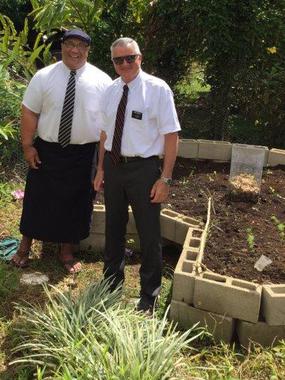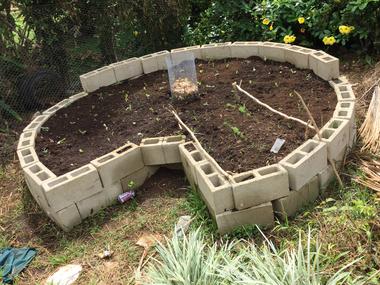
To some, Sam Williams is known as “the farm guy”. He plants demonstration vegetable gardens to test crops, soil and approaches to gardening that will help members of The Church of Jesus Christ of Latter-day Saints and communities in the Pacific grow food for their families.
Recent testing has included keyhole gardens. According to Sam, “A keyhole garden is a raised bed, composting, and recycling system all rolled into one. The design creates a garden that uses recycled materials, less water and maintenance. Kitchen and garden waste are added to the center basket. The soil bed layers are slightly sloped away from the center to help water and compost tea distribution. As the materials decompose, soil and composting materials are added to the bed in later growing seasons.”
The Hafokas, a family of eight who live in Tonga, built their keyhole garden in a square shape and fenced it with wood and wires. It stands about two and a half meters high so it is easy to tend and is out of the way of animals and people passing by.
“The first thing we put is cardboard boxes at the ground layer,” explains Elina Hafoka. “Then skin crops in the second layer, then after that we put soils in the middle layer, then more skin crops, and then soil with a basket in the middle of the keyhole.” Her family chose to plant onions, lettuce, and chili peppers.
Elina describes how her family benefits from their keyhole garden: “Every time we don’t have food, that’s where we get food, and we always have a good delicious dinner every evening.”

According to Sam, “Our demonstration farms in Samoa are used to test new ideas and growing techniques for different soil and weather conditions around the Pacific. Some ideas were more successful than others, but the keyhole garden concept and application has proven to work really well so far. I was introduced to the idea by a friend and mentor Dr. Malcolm Hazelman. By following a principle called K.I.S.S. (Keep it Simple & Sustainable), the keyhole garden has had a huge interest.”
The benefits of keyhole gardens over traditional gardens are:
- Keyhole gardens require only a small area of ground.
- The use of recycled material makes these gardens inexpensive or free to build.
- The short bed distance (from outer wall to the center basket) makes the garden easy to tend.
- Composting is easy. It works by adding garden waste to the handy center compost basket.
- The center compost basket provides a steady supply of plant nutrients.
- Due to moisture from mulching and from the center basket, a keyhole garden uses less water, so it has high drought-tolerance.
- Each garden can be modified to fit the owner’s needs, like a child being able to help or handicap accessibility.
- The raised design removes the threat of trampling by pets and humans.
Sam also cautions that the project “is young and has some teething issues we’re resolving as we go.” However, he adds, “It seems to have given families a new motivation and for some a new found love for gardening and eating better.”
Sister Anne Maughan, a senior missionary for the Church in Auckland, New Zealand, says, “When we were in Tonga we went to visit several keyhole gardens. They were beautiful, and [people] were eating vegetables from them. All of the gardens had a little different twist to them, some more effective than others.”